
I believe that adopting a healthy diet is essential for maintaining overall wellness. The Mediterranean diet, known for its delicious and nutritious foods, is an excellent choice for anyone looking to shed a few pounds. This diet not only helps with weight loss but also offers numerous health benefits, making it a sustainable option for long-term success.
When I explore the mediterranean diet recipe, I’m always impressed by the variety of ingredients it includes, from fresh fruits and vegetables to whole grains and healthy fats. This diversity makes it easier to create tasty meals that keep me satisfied while working towards my weight loss goals. Understanding the best recipes can help anyone embrace this healthy way of eating.
1. Mediterranean Quinoa Salad
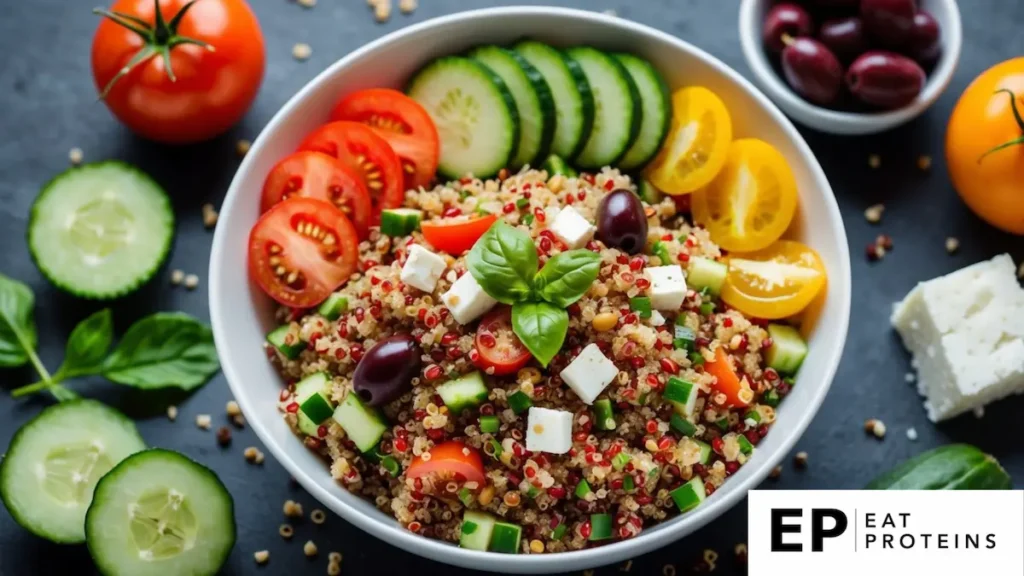
Mediterranean Quinoa Salad is a nutritious dish that I enjoy for its fresh flavors and health benefits. Quinoa is a whole grain high in protein and fiber, making it a great addition to my meals.
This salad is easy to prepare, taking about 15-20 minutes. I start by cooking 1 cup of quinoa in 2 cups of water. Once it boils, I reduce the heat and let it simmer for 15 minutes.
While the quinoa cooks, I chop my favorite vegetables, such as cucumbers, tomatoes, and bell peppers. I usually use about 1 cup of each. I also add 1/4 cup of red onion and a handful of parsley for extra flavor.
After the quinoa is done, I let it cool slightly. Then, I mix all the ingredients in a large bowl. I dress it with the juice of one lemon, 2 tablespoons of olive oil, salt, and pepper to taste.
This salad is refreshing, filling, and perfect for a light lunch or dinner. It keeps well in the fridge, making it a great option for meal prep.
2. Grilled Chicken Shawarma
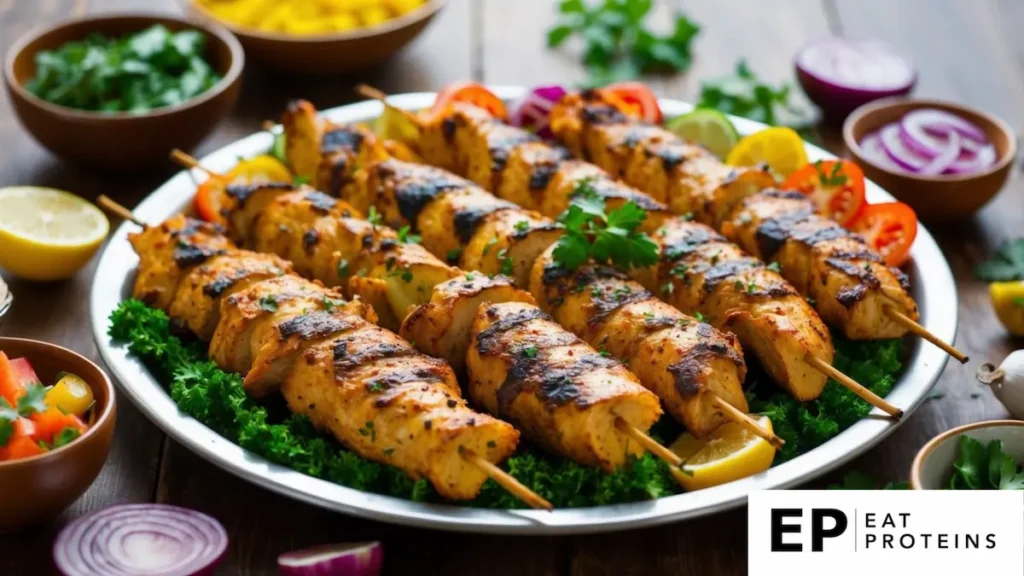
Grilled Chicken Shawarma is a flavorful dish inspired by Middle Eastern cuisine. It combines marinated chicken with spices, making it perfect for the Mediterranean diet.
This recipe is easy to make and requires simple steps. Here’s how I prepare it:
- Marinate the Chicken: In a bowl, mix yogurt, lemon juice, garlic, and shawarma spices. Coat the chicken with this mixture and let it marinate for at least 1 hour or overnight for better flavor.
- Preheat the Grill: I preheat my grill to medium-high heat. This is essential for getting that nice char on the chicken.
- Grill the Chicken: I place the marinated chicken on the grill and cook it for about 6-7 minutes on each side. I ensure the internal temperature reaches 165°F for safety.
- Rest and Slice: After grilling, I let the chicken rest for a few minutes. Then, I slice it into strips.
- Serve: I enjoy it with fresh vegetables, pita bread, or in a salad. It makes for a healthy, satisfying meal.
Grilled Chicken Shawarma is delicious and fits well into a healthy lifestyle.
3. Greek Salad with Feta
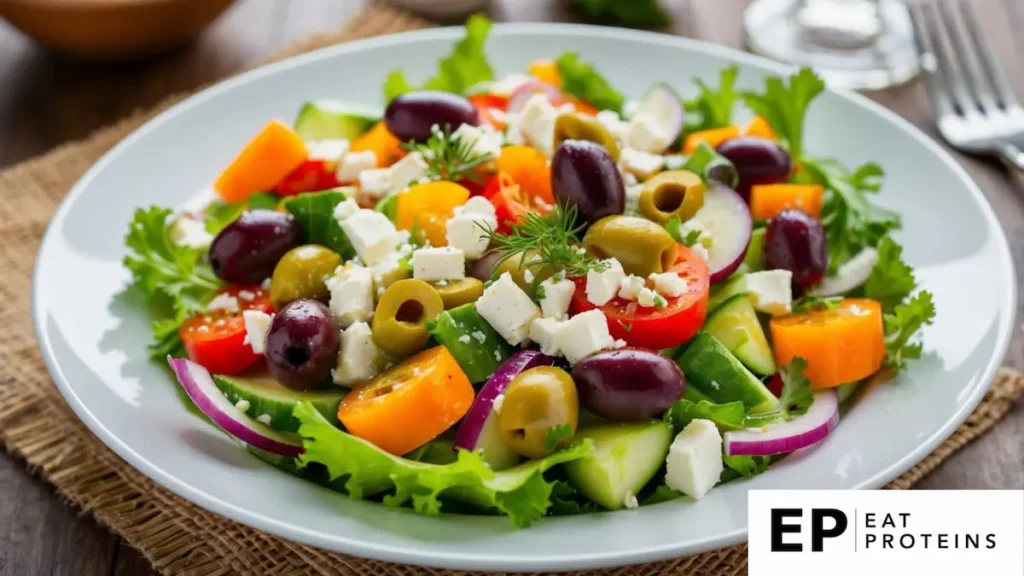
Greek salad with feta is a classic Mediterranean dish. It features fresh vegetables such as tomatoes, cucumbers, red onions, and bell peppers. Feta cheese adds a creamy and tangy flavor, making it a delicious choice for a healthy diet.
Making Greek salad is simple and quick. It is perfect for someone who wants to prepare a nutritious meal without much fuss. I find it easy to whip up in under 15 minutes.
Here’s how to make it:
- Gather Ingredients: I use 2 cups of chopped tomatoes, 1 cup of diced cucumber, 1 cup of sliced bell pepper, 1/2 cup of sliced red onion, and 1 cup of feta cheese.
- Mix Veggies: In a large bowl, I combine the chopped tomatoes, diced cucumber, sliced bell pepper, and red onion.
- Add Feta: I crumble the feta cheese over the top of the vegetables.
- Dress the Salad: I drizzle olive oil and red wine vinegar over the salad, then sprinkle with salt, pepper, and oregano.
- Toss and Serve: Finally, I gently toss everything together and serve it fresh.
This salad is refreshing and pairs well with many meals.
4. Stuffed Bell Peppers

Stuffed bell peppers are a flavorful and nutritious dish that fits well into the Mediterranean diet. They typically consist of bell peppers filled with a mixture of grains, vegetables, and proteins, making them a satisfying option for weight loss.
I find these peppers easy to prepare. The process takes about 30 to 40 minutes from start to finish. First, I preheat the oven to 375°F (190°C).
Here are the simple steps I follow:
- Prepare the Peppers: Slice the tops off 4 bell peppers and remove the seeds.
- Make the Filling: In a bowl, combine 1 cup of cooked quinoa, 1 cup of chopped veggies (like tomatoes and spinach), and 1/2 cup of feta cheese.
- Stuff the Peppers: Fill each pepper with the quinoa mixture.
- Bake: Place the stuffed peppers in a baking dish and cover with foil. Bake for 25 minutes.
These stuffed peppers are not only delicious but also provide a healthy dose of vitamins and minerals. They make for a perfect meal that is both filling and good for weight loss.
5. Vegetable Paella
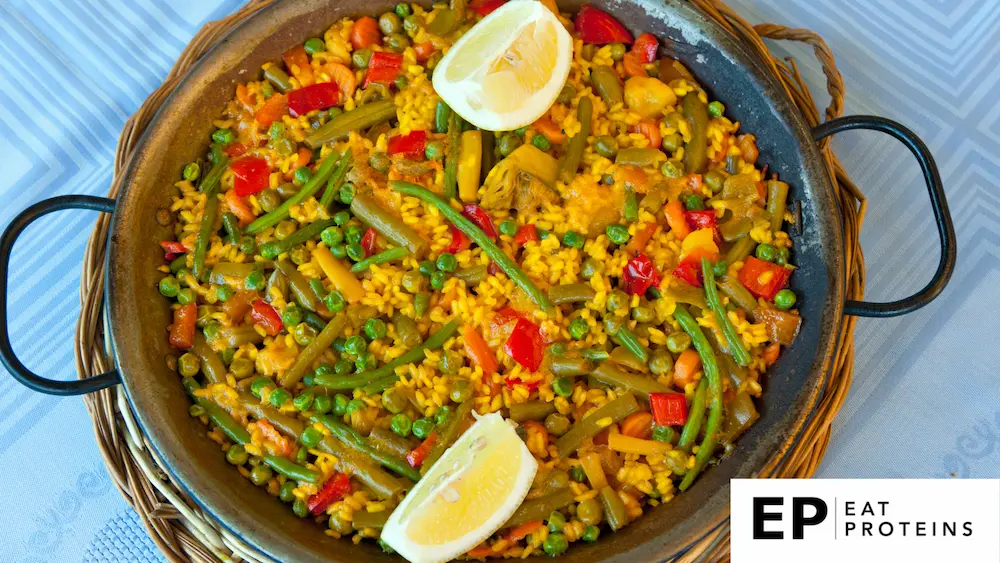
Vegetable paella is a colorful and flavorful dish that comes from Spain. It features rice, a variety of vegetables, and spices, particularly saffron, which gives it a unique taste.
I find vegetable paella easy to make, even for beginners. It requires basic cooking skills and common ingredients like rice, bell peppers, green beans, tomatoes, and garlic.
Here’s a simple way to prepare it:
- Heat olive oil in a large pan over medium heat.
- Sauté chopped onions and garlic until soft.
- Add sliced bell peppers and green beans, cooking for about 5 minutes.
- Stir in rice and cook for 2 minutes until slightly toasted.
- Pour in vegetable broth and add saffron, salt, and pepper.
- Bring to a boil, then lower the heat and simmer for 20 minutes until the rice is tender.
- Let it rest for 5 minutes before serving.
This dish is satisfying, healthy, and fits well within a Mediterranean diet. It’s easy to customize with seasonal vegetables or favorite spices. Enjoying vegetable paella can support my weight loss goals while offering delicious flavors.
6. Turkish Lentil Soup

Turkish Lentil Soup, or “Mercimek Çorbası,” is a nourishing and popular dish in Turkey. It is made primarily from lentils, which are rich in protein and fiber. This makes the soup a great option for weight loss.
I find this recipe easy to prepare. To make it, I typically gather the following ingredients: red lentils, onion, carrot, garlic, tomato paste, and spices like cumin and paprika.
Here are the steps I follow:
- Sauté: In a pot, I heat olive oil and sauté one chopped onion and one diced carrot for about 5 minutes until they soften.
- Add Garlic: Next, I add two minced garlic cloves and cook for another minute.
- Combine Ingredients: I stir in one cup of rinsed red lentils, one tablespoon of tomato paste, and my chosen spices.
- Add Broth: I pour in six cups of vegetable or chicken broth and bring everything to a boil.
- Simmer: Once boiling, I reduce the heat and allow the soup to simmer for about 25-30 minutes until the lentils are tender.
- Blend: For a smooth texture, I use an immersion blender and adjust seasoning to taste.
This comforting soup is not only healthy but also fills me up.
7. Baba Ganoush
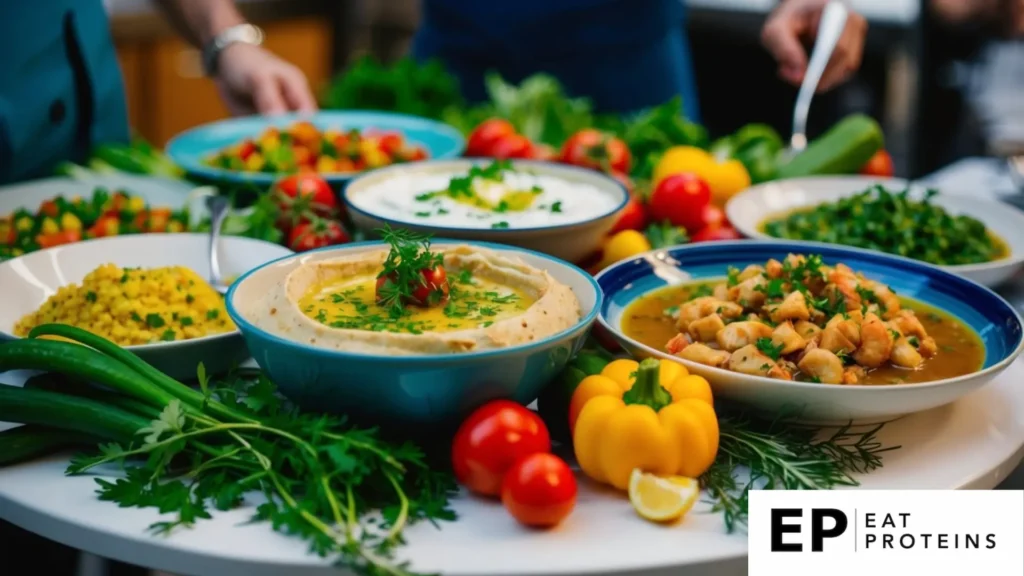
Baba Ganoush is a delicious Mediterranean dip made from roasted eggplant, tahini, garlic, olive oil, and lemon juice. It is not only flavorful but also a healthy choice for those looking to lose weight.
Making Baba Ganoush is simple. I find it easy to prepare with just a few ingredients. Here are the basic steps:
- Preheat the oven to 400°F (200°C).
- Cut one medium eggplant in half and place it on a baking sheet. Drizzle with olive oil and roast for about 30-35 minutes until soft.
- Allow the eggplant to cool, then scoop out the flesh.
- In a food processor, combine the eggplant flesh, 2 tablespoons of tahini, 1 minced garlic clove, juice of half a lemon, and salt to taste.
- Blend until smooth, adding olive oil for desired consistency.
Serve Baba Ganoush with pita bread, fresh vegetables, or as a spread on sandwiches. It’s a versatile option, perfect for snacking while staying on track with a Mediterranean diet.
8. Hummus and Veggie Wrap

A hummus and veggie wrap is a simple and healthy meal option. It features creamy hummus spread on a whole grain wrap, filled with fresh veggies. This dish is great for weight loss as it is low in calories but high in nutrients.
Making a hummus and veggie wrap is easy and quick. I can prepare it in just a few minutes. Here are the steps I follow:
- Start with a whole grain wrap or tortilla.
- Spread about 2-3 tablespoons of hummus evenly on the wrap.
- Add my favorite veggies like spinach, bell peppers, cucumbers, and carrots.
- Sprinkle some feta cheese or a few olives for extra flavor, if I like.
- Roll up the wrap tightly and slice it in half.
This dish is colorful, flavorful, and filling. I can also customize it by using different veggies or wraps. Enjoying it as a lunch or snack helps me stay on track with my healthy eating goals.
9. Chickpea and Spinach Stew
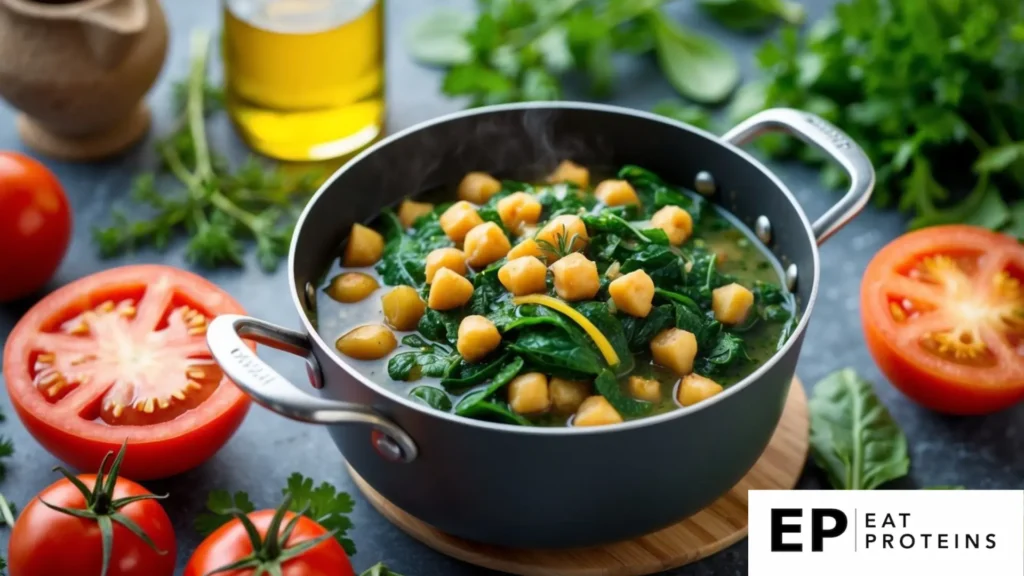
Chickpea and spinach stew is a healthy and satisfying dish. It blends protein-rich chickpeas with nutrient-dense spinach. This recipe is simple and quick, making it perfect for a weeknight meal.
To make it, I start by gathering my ingredients. I need canned chickpeas, fresh spinach, garlic, onion, vegetable broth, and spices like cumin and paprika.
Here are the steps to prepare it:
- In a pot, heat olive oil over medium heat.
- Add chopped onion and minced garlic. Sauté until they soften.
- Stir in the chickpeas and spices, cooking for a couple of minutes.
- Pour in vegetable broth, bringing the mixture to a simmer.
- Add fresh spinach and let it wilt for about 3 minutes.
- Season with salt and pepper to taste.
This dish cooks in about 20 minutes. It’s filling and has a balance of flavors. I often serve it with whole grain bread for a complete meal.
What Are the Basics of the Mediterranean Diet?
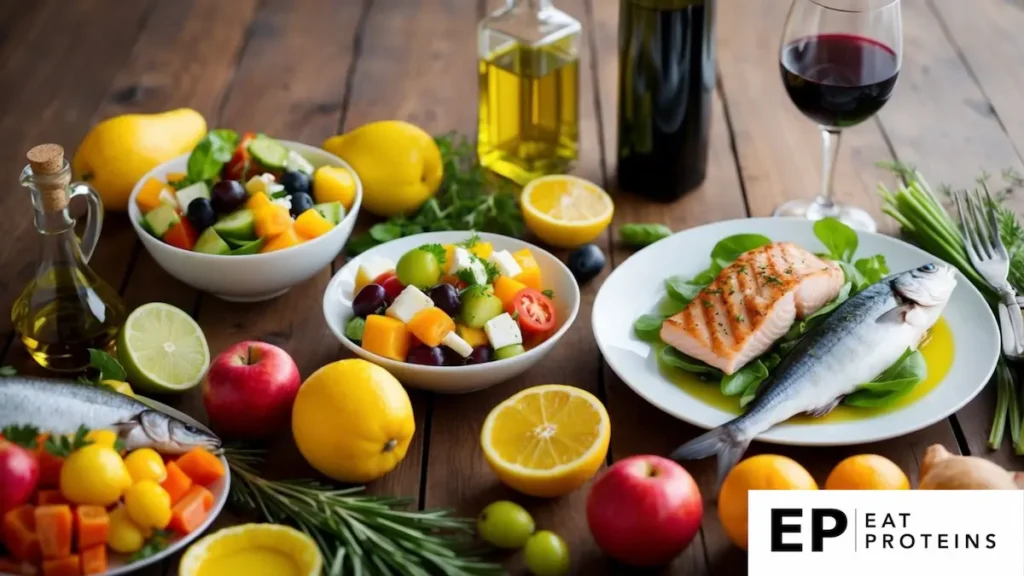
The Mediterranean diet is more than just a meal plan. It focuses on fresh ingredients, healthy fats, and a balanced lifestyle. Understanding its core principles and health benefits can help you incorporate this diet into your routine effectively.
What Are the Core Principles and Components of the Mediterranean Diet?
The Mediterranean diet emphasizes whole, unprocessed foods. Key components include:
- Fruits and Vegetables: I aim for at least five servings a day, which add essential vitamins and minerals.
- Whole Grains: I choose foods like brown rice and whole wheat bread for fiber and energy.
- Healthy Fats: Olive oil is my primary fat source. It provides heart-healthy monounsaturated fats.
- Lean Proteins: I include fish, chicken, beans, and legumes, while limiting red meat.
- Dairy: I prefer low-fat options, such as yogurt and cheese.
- Herbs and Spices: I use these to flavor dishes instead of salt, enhancing taste and nutrition.
What Are the Health Benefits of the Mediterranean Diet?
I find that following the Mediterranean diet offers numerous health benefits. Research suggests it can:
- Reduce Heart Disease: The diet’s healthy fats and fiber can lower bad cholesterol levels and support heart health.
- Support Weight Loss: Eating whole, filling foods keeps me satisfied, which helps manage weight.
- Lower Diabetes Risk: A focus on low glycemic index foods can stabilize blood sugar levels.
- Boost Mental Health: Some studies indicate a connection between this diet and reduced depression or anxiety.
By following this diet, I enjoy flavorful meals while supporting my overall health.
How Does the Mediterranean Diet Promote Weight Loss?
Weight loss Mediterranean diet recipes focus on nutrient-dense foods, balancing macronutrients, and managing caloric intake. These principles help me maintain a sustainable and healthy diet.
What Nutrient-Dense Foods Are Included in the Mediterranean Diet?
I emphasize the inclusion of whole, non-processed foods in my meals. This approach ensures I get a range of vitamins and minerals without excessive calories. Foods like fruits, vegetables, whole grains, legumes, nuts, and healthy fats, especially olive oil, make up the core of the Mediterranean diet.
These foods not only provide essential nutrients but also keep me full longer. Eating a variety of colorful fruits and vegetables means I benefit from diverse nutrients that support my overall health, enhancing my weight loss efforts.
How Does the Mediterranean Diet Balance Macronutrients?
Balancing macronutrients is crucial in the Mediterranean diet. I typically include moderate amounts of carbohydrates, healthy fats, and proteins in my meals. This balance helps me feel satisfied while providing steady energy throughout the day.
For example, I might pair whole grain bread with hummus and a side of veggies for a balanced snack. The healthy fats from olive oil and nuts help me absorb nutrients and keep my heart healthy. With this balance, I avoid the blood sugar spikes that can lead to cravings.
How Does Caloric Intake and Satiety Work in the Mediterranean Diet?
Managing caloric intake is essential for weight loss. The Mediterranean diet emphasizes portion control and eating in moderation. I find that by focusing on whole foods, I naturally consume fewer empty calories.
Additionally, the fiber in fruits, vegetables, and whole grains enhances my feeling of fullness, making it easier to resist unhealthy snacks. Drinking water and including soup-based dishes can also help regulate my appetite, making it simpler to stick to my weight loss goals.
How Can You Incorporate Mediterranean Diet Recipes Into Your Routine?
I find that integrating Mediterranean diet recipes into my daily life is both rewarding and simple. Focused meal planning, using common ingredients, and maintaining a balanced approach help me enjoy the benefits of this healthy eating style.
What Are Some Meal Planning and Preparation Tips for the Mediterranean Diet?
Planning meals ahead of time is crucial for success. I usually set aside time each week to create a menu. This helps me include a variety of Mediterranean dishes, making grocery shopping easier.
I like to use a mix of fresh and pantry-stable ingredients. Preparing large batches of grains like quinoa or brown rice allows for quick meals during the week. To save time, I often chop vegetables in advance and store them in the fridge.
Also, consider theme nights. For example, “Tasty Tuesdays” could feature a different Mediterranean recipe every week. This not only keeps things interesting but also makes meal prep something to look forward to.
What Are Common Ingredients and Substitutions in the Mediterranean Diet?
Certain ingredients are staples in the Mediterranean diet and can easily be swapped depending on availability.
For instance, instead of using regular pasta, I often try whole grain or chickpea pasta. This adds extra fiber, which is beneficial for weight loss.
Olive oil is my go-to for cooking and dressings. If I’m out, I use avocado oil as a substitute. When recipes call for fresh herbs like basil or parsley, dried herbs work just as well in a pinch.
Exploring local markets helps me find seasonal produce, which is ideal for making vibrant salads and sides.
How Can You Maintain a Balanced Diet with the Mediterranean Diet?
It’s important to ensure my meals are balanced. I include lean proteins, such as chicken or legumes, with each meal. For example, a grilled chicken salad is a great way to combine protein and vegetables.
I aim to fill my plate with a variety of colors. This not only looks appealing but also adds essential nutrients. I try to include whole grains and healthy fats like nuts or seeds in my meals.
Listening to my body’s hunger cues helps me understand when I’m full. This mindful approach is key in maintaining a healthier, balanced diet while enjoying the Mediterranean lifestyle.
